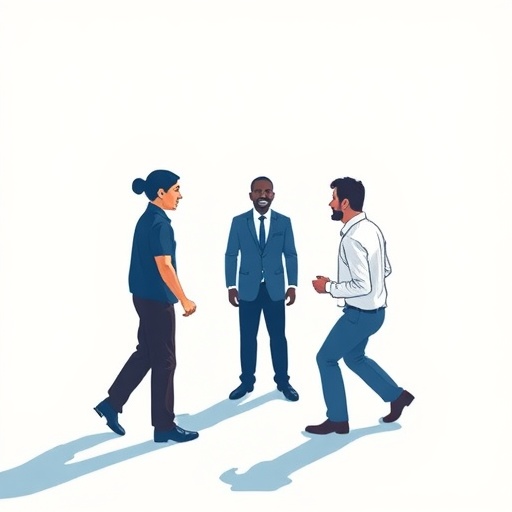In recent years, the investigation into cooperative behavior among humans, especially in task performance, has gained significant attention. This research has not only important implications for understanding teamwork dynamics but also offers insights into designing more effective human-robot collaborations. A revealing study led by Assistant Professor Asuka Takai from Osaka Metropolitan University has provided valuable evidence regarding the conditions under which cooperation enhances task performance.
The study centered around a straightforward yet intriguing experiment: pairs of participants were tasked with controlling a robotic arm to transport a rod while maintaining its horizontal position. A distinct hindrance was in place—the rod’s tilt had to remain within a specified threshold, presenting a measurable challenge that would determine the success of their cooperation. To investigate the influence of teamwork, the participants were divided into two groups: one group operated together, while the other worked alone, thereby allowing the researchers to analyze their performance outcomes.
An essential aspect of the research was the experimental design that incorporated two distinct conditions. The first condition, termed the ‘symmetric’ condition, allowed for equal contribution from both participants since the rod’s axis was centered. Under this scenario, one might hypothesize that equal participation would maximize efficacy. Conversely, in the ‘asymmetric’ condition, the challenge escalated as the rod’s rotation axis was deliberately off-center. This setup resulted in uneven arm lengths among the participants, providing an inherent advantage to one participant, who was required to lead while the other provided support, thereby creating a more complex cooperative dynamic.
The study indicated a fascinating trend. In the asymmetric condition, pairs exhibited a remarkable ability to adjust their movements, learning and iterating with each trial. This led to the emergence of a natural division of roles. One participant typically took a leading position while the other acted as a supportive counterpart. The resulting synergy allowed pairs to outperform those working alone, showcasing a clear ‘cooperative advantage’ that had long been theorized but remained untested in practical terms.
Interestingly, the outcomes were different under the symmetric condition. In instances where participants could not assume distinct roles, no clear advantage emerged from collaboration, undermining the premise that teamwork is always favorable. In fact, pairs who lacked role differentiation often found themselves taking longer to complete tasks than their individual counterparts. This counterintuitive finding highlights the importance of role specialization within cooperative contexts.
Professor Takai, reflecting upon these nuanced dynamics, stated, “Our research has established that when a distinct ‘leader-follower’ relationship is formed under physically asymmetric conditions, cooperative performance markedly improves.” This insight points to a critical understanding that simply working together is not a surefire way to enhance task performance; instead, it is the specialization of roles and the natural emergence of leadership within a team that truly drives efficiency.
This research holds significant implications beyond the laboratory setting. One of the primary applications suggested by Takai and the team is in the realm of rehabilitation and human-robot interaction. Understanding how asymmetric dynamics can foster role specialization offers a pathway toward more effective collaborative design between humans and robots. It places a critical focus on the shared responsibilities between operators and robotic assistants, thus enabling sophisticated interaction models that can optimize task completion.
Furthermore, as technology continues to advance, particularly in robotics, the insights gleaned from this study could inform how future robots are programmed to interact with humans. A critical component of this would involve equipping robotic systems with the capability to discern when to take on a task independently or when to yield control to a human. This nuanced awareness could significantly enhance collaborative task performance, making the human-robot synergy more seamless and productive.
The findings of this research are particularly noteworthy as they challenge some long-held assumptions about collaboration. The implications of these results stretch across various fields, including occupational training, collaboration in work environments, and even interpersonal relationship dynamics, underlining the complexity of teamwork. By acknowledging that not all teamwork is beneficial and that effective cooperation requires defined roles, society can design better collaborative experiences, whether in workplaces, rehabilitation centers, or educational institutions.
In conclusion, this compelling study provides a fresh lens through which to view cooperative dynamics. It emphasizes that the essence of teamwork is not simply to work together but to understand and explore how roles can be effectively split according to the strengths of each participant. The nuances discovered in this research pave the way for future explorations into collaboration, highlighting that effective leadership and role adaptability can transform the way we approach tasks, not just among humans but also in the evolving domain of human-robot interaction.
With the push towards automation and shared tasks between humans and machines, understanding these dynamics becomes ever more critical. As the fields of robotics and artificial intelligence continue to progress rapidly, insights such as these are at the forefront of guiding the design of more intuitive and effective collaborative systems. They remind us that in working together—be it with fellow humans or intelligent machines—how we interact can make all the difference in achieving our goals efficiently and successfully.
Subject of Research: People
Article Title: Role specialization enables superior task performance by human dyads than individuals
News Publication Date: 25-Aug-2025
Web References:
References:
Image Credits: Osaka Metropolitan University
Keywords
Cooperation, Task Performance, Robotics, Role Specialization, Human-Robot Interaction.
Tags: conditions for effective cooperationcooperative behavior in task performanceequal contribution in cooperative tasksexperimental study on teamwork efficiencyhuman-robot collaboration insightsimpact of teamwork on performance outcomesimplications for designing collaborative systemsleader-follower dynamics in teamworkrobotic arm task performance analysissymmetric vs asymmetric task conditionsteamwork dynamics in experimental psychologyunderstanding human cooperation in robotics





